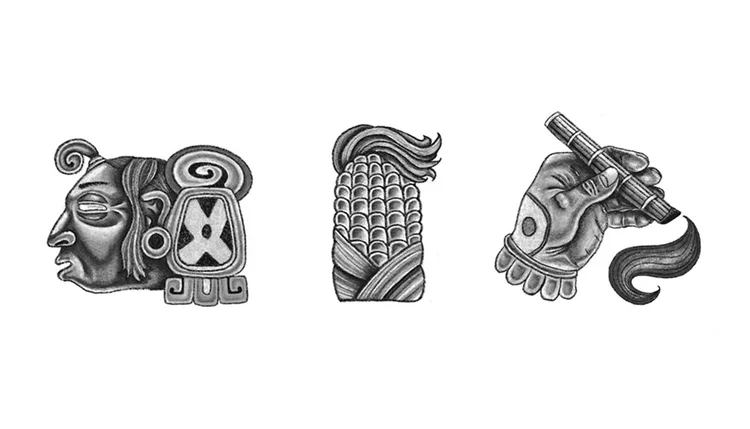Juego de Pelota - 37” W x 36” H, Pencil on Painted Wood
How Was the Game Played?
The Mesoamerican ballgame was played in many different ways, much like how a modern basketball court can host different games like 21 or Knockout. While the general objective was to keep the ball in play using only the hips, knees, and elbows, the exact rules varied across time and region, and were considered somewhat unknown. Some versions of the game may have involved scoring points by hitting the ball against markers on the walls, but the most dramatic victory condition was getting the ball through a stone ring—a rare and difficult feat that resulted in an automatic win. The game was deeply political, often serving as a way for different city-states to assert dominance or settle disputes without resorting to war. Leaders of powerful regions sent their best players to compete, and in some cases, rival kings even faced off one-on-one to resolve conflicts. The ballgame was not just a sport but a tool for diplomacy, strategy, and even survival.
Fun Facts About the Mesoamerican Ballgame
Oldest Team Sport in the World – The game originated around 1650 BCE with the Olmecs and is one of the oldest known team sports.
The Ball Was Made of Rubber – Mesoamericans harvested latex from trees to create rubber balls, making them the first civilization to use rubber in sports.
The Ball Was Heavy – Some balls weighed up to 9 pounds (4 kg), making the game physically demanding and even dangerous.
Courts Were Aligned to Celestial Events – Many ballcourts were built to align with the sun, moon, and important star patterns, reinforcing the game’s cosmic significance.
Still Played Today – Modern versions of the game, like ulama, are still played in some Indigenous communities in Mexico.
Ballcourts Across Mesoamerica
Ballcourts have been found throughout the Mesoamerican region, from Mexico to Central America. Over 1,500 ballcourts have been discovered, proving its widespread cultural significance.
Mexico
Mexico has over 1,300 ballcourts, with the largest concentration in the Maya region of the Yucatán Peninsula.
The most famous ballcourt is at Chichén Itzá, measuring 96.5 meters (316 feet) long—one of the largest ever built.
Other major sites include Monte Albán, El Tajín, Teotihuacan, and Copalita.
Guatemala
Guatemala has over 500 ballcourts, primarily in ancient Maya cities.
Important sites: Tikal, Uaxactún, Quiriguá, Yaxhá, Nakbé, and El Mirador.
The Tikal ballcourt is one of the best-preserved, showcasing Maya artistry.
Honduras
Home to one of the most iconic ballcourts in the world, located in Copán.
The Copán ballcourt (built around 700 CE) features carved macaw heads, symbolizing the connection between the underworld and the heavens.
Belize
Belize has several ballcourts, mostly within ancient Maya ruins.
Major locations: Caracol, Lamanai, Xunantunich, and Altun Ha.
Nim Li Punit has a unique court with carved stelae depicting ballgame players.
El Salvador
The most famous ballcourt in El Salvador is at Tazumal in the Chalchuapa region.
Cihuatán also has ballcourts, showing strong influences from both Maya and Central Mexican cultures.
Nicaragua
Nicaragua has few confirmed ballcourts, but the Zapatera Island ruins and El Rayo contain remnants of ballgame-related structures.
Some researchers believe the ballgame may have been played in Granada and other ancient settlements (not clear).
Costa Rica
Costa Rica has limited evidence of Mesoamerican ballcourts but some influences appear in Guayabo de Turrialba and sites in the Nicoya Peninsula, where Mesoamerican and local cultures merged.
Indigenous groups like the Chorotega may have adapted their own versions of the game.
The Mesoamerican ballgame was more than just a sport; it was a sacred tradition woven into the cultural and spiritual fabric of ancient civilizations. From Mexico to Costa Rica, ballcourts served as grand arenas where myth, politics, and athleticism merged. Today, the remnants of these courts continue to tell the story of a game that once connected the heavens, the earth, and the underworld.
Chinkultic disc, Maya Late Classic (600-900 A.D.) Chinkultic, State of Chiapas, Limestone
Mexico, Nayarit, 200 BCE–500 CE, Ceramic
Monument 171 from Tonina, Chiapas, showing the king of Calakmul, at right, playing ball with the deceased ruler of Tonina K’inich Baaknal Chahk
Ballcourt in Copán, Honduras
Ballcourt in Cihuatán in San Salvador, El Salvador
A ballgame scene painted on a cylindrical, ceramic vessel that dates to between A.D. 682 and 701. (Image credit: Courtesy of the Dallas Museum of Art)







